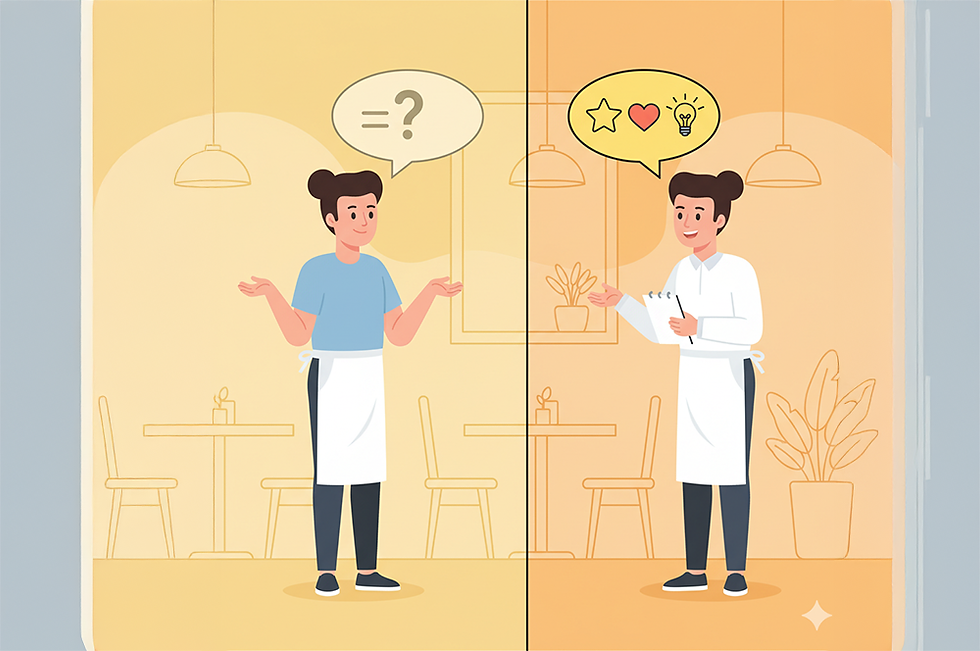Restaurants: How to Gather Customer Feedback That You Can Actually Use
- Phil Ingram

- Sep 14
- 3 min read

"How was everything?"
It’s the question servers have asked since the dawn of restaurants. And 99% of the time, the answer is a polite, but utterly useless, "Fine, thanks."
Let's be honest, that feedback for your restaurant is the culinary equivalent of a shrug. It tells you nothing. You don’t know if "fine" meant "spectacular, I’m telling all my friends," or "perfectly adequate, but I won’t be rushing back." This ambiguity is a killer. You can't build a better business on a foundation of ‘fine’.
To truly improve your service, refine your menu, and keep customers coming back, you need feedback with substance. Here’s how to get it.
1. Ditch the Generic and Get Specific
The first step is to empower your front-of-house team to be better detectives. Instead of the generic catch-all, train them to ask targeted, open-ended questions at the right moment.
Instead of: "Did you enjoy your meal?"
Try: "What was your favourite dish tonight?" or "We’ve just added the sea bass to the menu, how did you find the flavour profile?"
Instead of: "Was the service okay?"
Try: "Is there anything at all we could have done to make your visit even better this evening?"
These questions invite an honest answer. They show you care about the details and make the customer feel that their opinion is genuinely valued, not just a box-ticking exercise.
2. Make It Easy and Almost Invisible
People are busy. Asking them to fill out a long survey is a big ask. The trick is to make providing feedback as easy as possible.
Smarter Comment Cards: Don't just leave a blank card. Structure it. Ask for a 1-5 rating on three key things: Food, Atmosphere, and Service. Then add two simple, open boxes: "One thing we did brilliantly:" and "One area for improvement:". This gives you quantitative data and qualitative insights in a flash.
The Simple QR Code: A small QR code on the bill or menu that links to a super-simple, one-page form can work wonders. Crucially, it must be mobile-friendly and take less than 60 seconds to complete.
3. Listen to the Digital Chatter
Whether you actively seek it or not, customers are already talking about you online. Ignoring this is like leaving free market research on the table.
Set Up Alerts: Create Google Alerts for your restaurant's name.
Monitor Key Sites: Regularly check Google Reviews, TripAdvisor, and any local foodie blogs or Instagram accounts.
Engage, Don't Argue: Respond to reviews—both good and bad. Thank people for positive comments. For negative ones, acknowledge their experience professionally, thank them for the feedback, and state that you're looking into it. A public, measured response shows everyone you’re listening and you care.
4. Turn Murmurs into Action
Gathering feedback is only half the battle. The real magic happens when you use it.
Log Everything: Keep a simple spreadsheet or notebook. Every time a specific piece of feedback comes in—a dish was too salty, the music was too loud, a server named Chloe was fantastic—write it down.
Spot the Patterns: One person’s comment is an anecdote. Five people making the same comment is a trend. These patterns are your roadmap for improvement.
Share with the Team: Feedback is a powerful tool for training and morale. Celebrate the wins ("Everyone, we’ve had three mentions this week about how great the new cocktails are!") and discuss the challenges constructively ("A few people have mentioned a draught from the door; let's see what we can do about that.").
Your Best Restaurant Feedback Comes from Your Biggest Fans
Here’s the bottom line: the most valuable, constructive, and insightful feedback will always come from your regulars. They are invested. They want you to succeed. They’ll tell you the truth because they want to keep coming back to a place they love.
The first step to cultivating this kind of relationship is turning a casual visitor into a loyal customer. Making them a member of your own loyalty program creates a bond. It says, "You're part of our community now," and opens a direct line for the kind of honest feedback that money can't buy.
With a platform like meed, you can create that program in about a minute. No apps, no fuss. Just a simple way to recognise your regulars and make them feel like the valued insiders they are—the very people who will help you go from "fine" to "unforgettable."




Comments